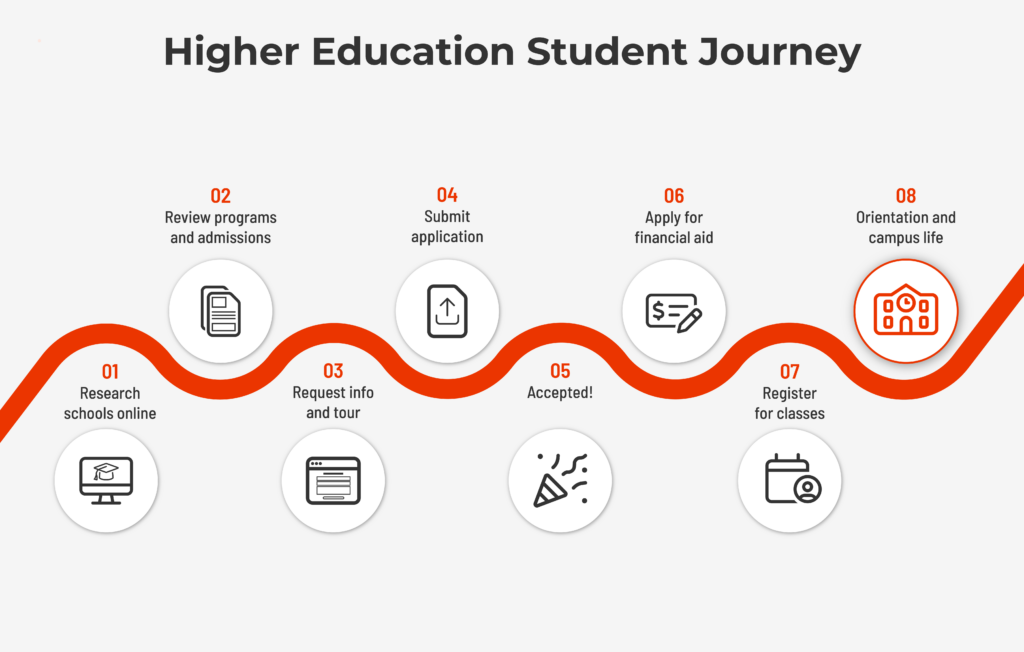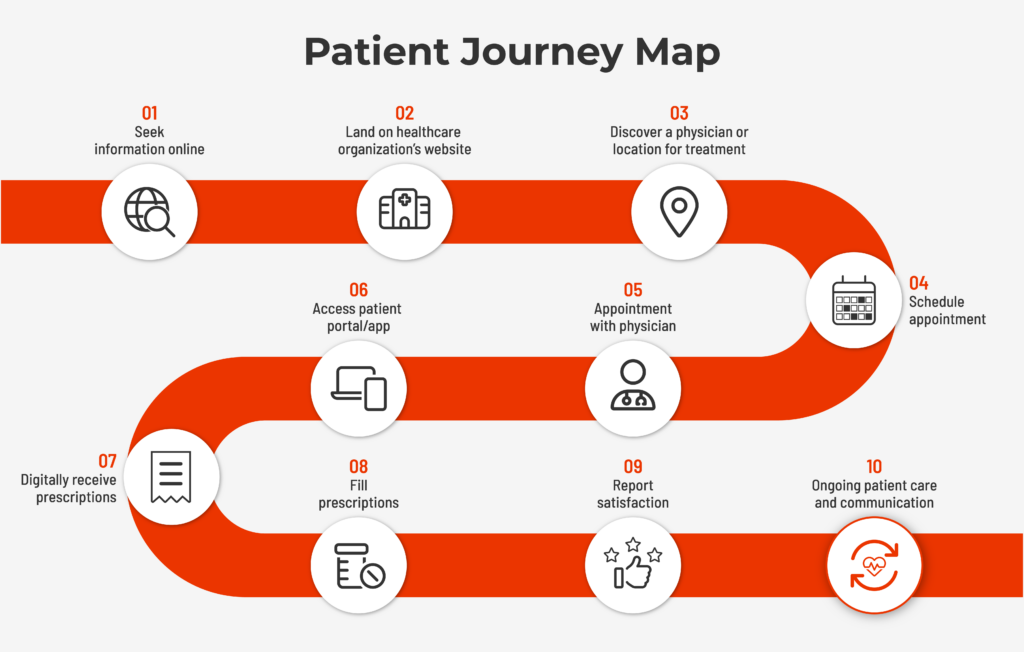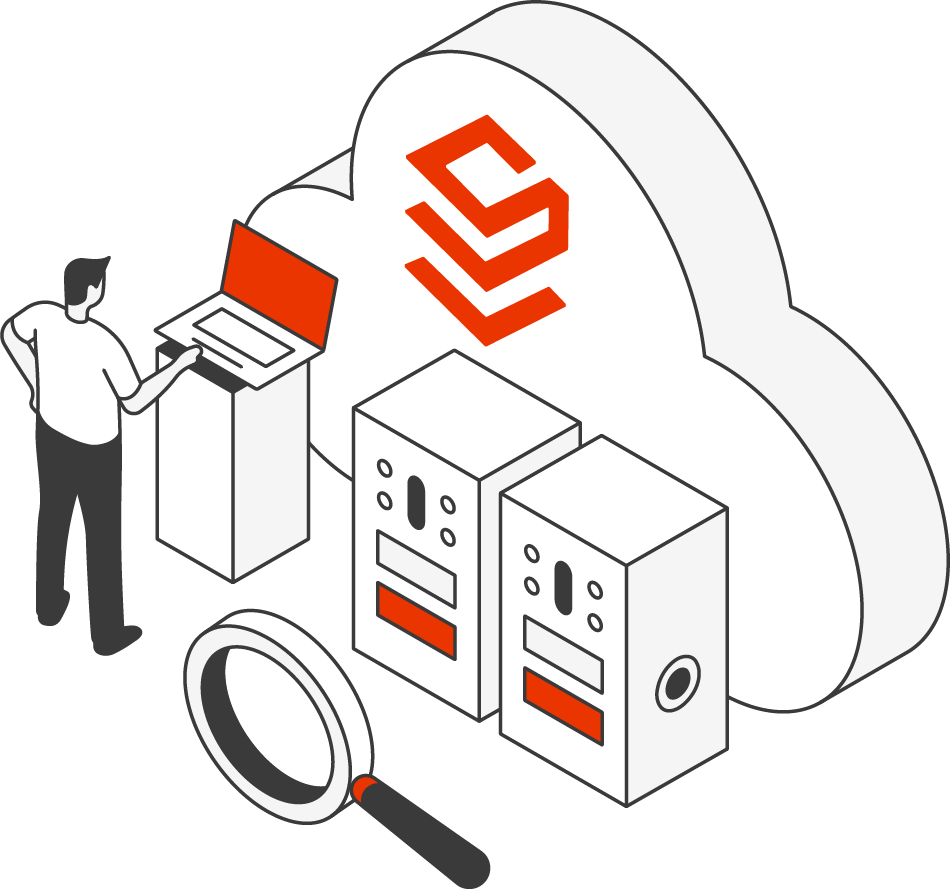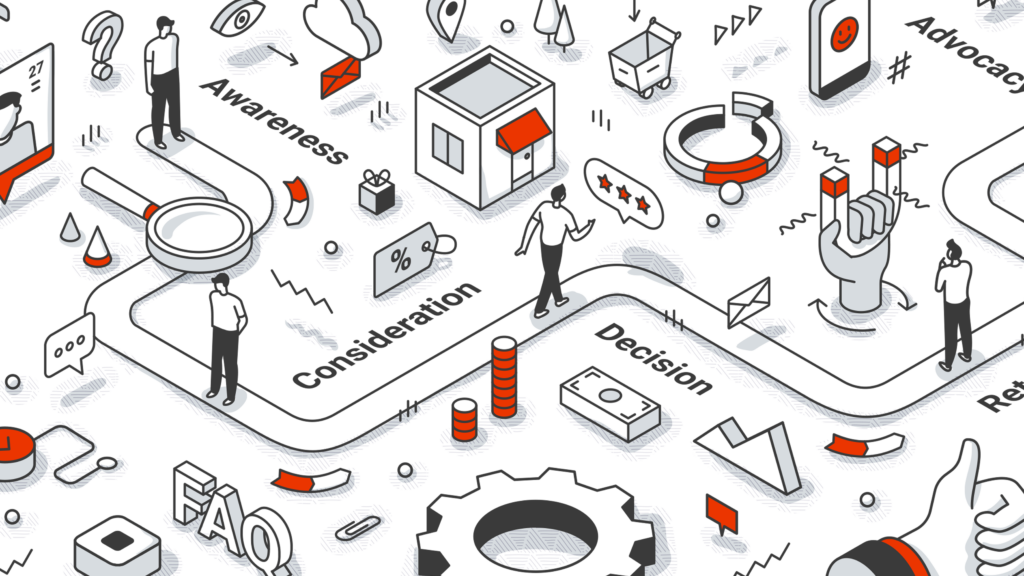August 26, 2024
John Abbasi
|
Customer journey mapping is an essential process for marketers to deliver a great experience that converts. But the modern customer journey map needs to consider what happens when visitors go off the rails of the curated path and beyond.
Redefining How to Build an Effective Customer Journey Map
Customer journey maps give organizations a chance to understand and improve the key touchpoints, channels and digital pathways their customers take to conversion. Learning how to map the customer journey is a great first step, but going beyond the basic mapping process is essential to staying agile and on top of your customers’ needs.
Consider a typical customer. No matter how well your brand is established, and no matter how you present your website content, will the customer take your ideal path to conversion every time?
Almost never.
Most often, they’ll jump right to your search bar to find exactly what they need.
The solution is to build a customer journey that fits their needs and is optimized to deliver an exceptional website experience even when visitors stray from the planned path to your search bar. We want to help you see your journey differently and give your mapping an edge over the competition.
What is a Customer Journey Map?
A customer journey is the series of steps and engagements a person experiences before, during and after becoming a customer of a service, brand or product. The customer journey encompasses the entirety of a customer’s interactions with an organization, be it through a digital ad, exposure on social media, reading a guest blog or otherwise. The variations of touchpoints are virtually endless.
A customer journey map is a complete overview of all the interactions the customer experiences in their journey. The journey map provides important insight into the efficacy of a company’s marketing touchpoints and highlights moments when a visitor moved closer or further from becoming a customer.
Why is Customer Journey Mapping so Important?
Creating a customer journey map, when done correctly, can completely change the way you interact with customers. Here are some of the most common benefits that come from mapping:
- Provides organizational insight about customer lifecycles. Mapping offers connectivity within a company/organization, bringing interdepartmental adherence as each team understands the steps of their typical customer journey – including pain points, areas for improvement and more.
- Results in higher quality leads. It’s crucial to target the right types of people with your marketing campaigns, those more likely to become leads and then customers. Because mapping shows customer behaviors, it gives marketers a way to address the needs of their customers at specific points in the funnel, producing more qualified leads.
- Reduces churn rate. The best mapping process illuminates patterns of current and previous customers, including the patterns that occur right before or at the moment of the customer switching to a different company’s product/service. This informs strategy to reduce churn.
Understanding the Customer Journey
The traditional customer journey isn’t a mystery at this point; it has well-defined key stages and necessary elements for success that marketers should consider when mapping their journey.
At this point, you’re likely familiar with the 5 stages of the journey: Awareness, Consideration, Decision, Retention and Advocacy. Rather than focusing on those well-defined stages, we want to zoom in on the tactical elements for how to build the base of your customer journey map and then discuss the layers that can elevate the experience.
Key Elements of a Customer Journey Map
Before we consider the optimal way to build a customer journey map, let’s look at some of the most important elements that make it up:
- Touchpoints. Touchpoints are interactions between customers and your organization. These can range from communications on social media, offline event interactions, website visits and more.
- Customer emotions. Though not the most concrete element, there are methods to gain insight into a customer’s emotions that arise as a result of their experiences with your brand. For example, a questionnaire could help reveal the ways customers are enjoying the overall experience.
- Pain points. Pain points drive customers toward or away from a company; your customer journey map should identify and correct them as soon as possible.
- Access considerations. Part of any good mapping will consider the types of access customers have, including things like the devices on which they access your company websites, products or services. There may be drastic differences between customers who exclusively use mobile devices, for example, compared to those who don’t.
- Customer personalities and demographics. Customer journey maps should highlight the different customer types your organization will encounter, giving a better understanding of how to connect with customers.
Creating a Customer Journey Map
The best process for creating a customer journey map includes 5 steps:
- Gathering materials
- Defining goals
- Highlighting touchpoints
- Including pain points
- Testing and iterating
1. Gather all Prerequisite Materials
Before starting the mapping process, you’ll want to gather all necessary information and materials and put them in order.
Gather customer data/analytics
First, take account of your current customer data situation: what types of data would be important, what information do you already have and what data would be helpful to collect? Make sure you have a process or tool in place to easily analyze and segment your customer data.
Identify customer personas
Part of a successful map is the ability to narrow customers down into different categories. That way, you’re able to see the paths they take and what works best for them on a more personalized level. To kick off this process, you’ll want a clear understanding of the many different customer personas and demographics in your customer base.
Take into account their specific goals in using your product or service. What are they trying to achieve or solve?
2. Define Detailed Mapping Goals
The mapping process can be a nebulous process without clearly defined goals. Before starting one, record the most important reasons a customer journey map would be beneficial for your company.
What would a highly successful map look like and what types of decisions would it ultimately open up to you? How would the customer experience improve as a result of your new mapping?
3. Highlight Touchpoints and Channels
Your customers are each unique, so identifying the different touchpoints they encountered along their journey is crucial to map and learn from. It’s also important to know the channels and devices your customers use to connect with your brand. The more this is recorded, the better you’ll be able to improve customer experience.
4. Include Pain Points
It’s not always easy finding pain points without direct communication between customer and organization. But there are other ways to go about pinpointing patterns where customers may struggle within your systems. During your planning stage, you can ask team members to test out the proposed follow to see where they experience friction.
Once you’ve implemented your customer journey, look for places where customers experience bottlenecks or roadblocks in achieving the goals you identified above. The pain points you hypothesize will often not be what your customers experience when moving through the funnel; it’s important to stay agile and to keep up with your customers’ pain points.
5. Test and Analyze Results for Iteration
Your customer journey map isn’t finished once you complete the first iteration. If you don’t test and analyze it, you’ll leave a lot of potential improvement on the table. Be sure to periodically evaluate your customer journey maps to ensure they’re up to date with your current data and strategy in mind.
Also remember that a map usually applies to a specific customer type. There will be different maps for different customer profiles.
Map-Building Best Practices
Though you’ll have different customer journey mapping processes based on your ideal customer, there are some universal best practices to follow.
Leverage Internal Collaboration
This is something that often goes overlooked in a mapping process, as it can be easy to get caught up in your own team’s construction and application of a customer journey map.
It’s important to:
- Request and implement insights from cross-functional teams.
- Ensure extensive collaboration with customer-facing teams.
Conduct Data Analysis
A customer journey map without comprehensive data analysis is bound to fall flat. Incorporate high-quality customer data into each mapping process to ensure your map points to the right issues to correct. When including data, remember to use both qualitative and quantitative data, as well as incorporate customer feedback and analytics.
Build Mapping Visuals
A strong visual representation helps teams get a better feel for the overall structure of the map, which helps them better address any issues it uncovers.
Here are a couple examples of visuals that helped simplify complex customer journeys.

As you can see in this example journey map, a higher education institution would want to carefully map out the most important touchpoints and phases of a prospective student’s journey to attending their school.
The map is easy to follow and helps with planning thoughtful follow ups and personalized communication at each stage of the journey.
It’s great to start with a flow of the main touchpoints and moments for a customer (or student in this example).
Additional mapping layers could include:
- Pain points that prospective students may encounter
- Types of devices they may be accessing information on for each stage
- Forms of communication between the institution and the student along the way
Next we have a journey map for a typical patient who is on the road from content discovery to becoming an ongoing patient with a healthcare provider. This maps out all critical touch points and moments in the journey when the healthcare provider would need to optimize to deliver an exceptional experience.

Some of those moments may seem like smaller, expected processes but have a major impact on the patient’s experience and perception of the healthcare company.
For example, receiving and filling prescriptions in a digital format needs to be optimized for the smoothest process possible. Not only is it essential for people’s healthcare needs, but it’s also critical to optimize the digital experience so that people know they can rely on the company’s website or app. It’s a worthy touchpoint to note on a customer journey map like the example above.
Update Journey Maps Regularly
Lastly, no customer journey map will be relevant forever. Ensure your mapping is a dynamic process that adapts to changes in product, service, website and customers.
The Missing Link for Customer Journey Maps: Site Search
Customer journey mapping involves planning and curating for the ideal pathways to content and pages people need to navigate in order to convert to customers. But that’s just it; it’s an ideal scenario that you optimize for, but can’t guarantee your visitors will follow.
One of the most common ways visitors break the expected customer journey path is by searching exactly what they need to find on the organization’s website.
When a customer uses your website’s search bar, you want to be confident that they won’t exit the site out of frustration with the search results. Additionally, site search should be an asset to your customer journey, bringing them a better experience, even when they deviate from your original curated path.
Prioritizing site search means equipping your marketing team with the ability to understand common search queries, the means to identify content gaps and the agility to make changes to search outcomes to best fit your visitors’ behaviors.
From a mapping perspective, site search gives companies the power to analyze detailed data and optimize for this commonly overlooked aspect of the customer journey. Many visitors will inevitably use your search bar; it’s up to you to connect them with the content they need through a great search experience.
If you’re looking for a site search solution to improve search outcomes and performance on your site, check out our Site Search solution.
How Well Do You Know Your Customers?
If you’ve taken the time to build extensive customer journey maps, your team will get to know your customers on a deeper level and be able to personalize the journey. You’ll be able to better identify pain points and bottlenecks in the journey and fine-tune the experience.
It’s almost like a superpower for organizations, and it starts with understanding stages of the customer journey, building out a map, including analysis from site search and putting it all together to deliver an elevated experience.




